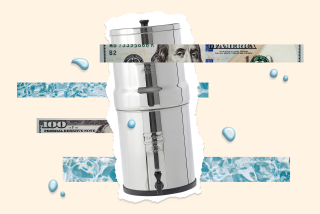Water Filtration Gains Popularity : Many Homeowners Concerned About Pollution Threat : from
- Share via
It’s no secret that household water-treating equipment has skyrocketed in popularity in the past 10 years. In the last two years alone, this sales volume--mostly water filters--has tripled, according to the Water Quality Assn.
Water-filter popularity results from increased awareness of industrial and other water pollutants such as pesticide runoff affecting drinking water quality. And then, there’s the matter of taste. Bottled water is far more expensive than filtering your own either right at the tap or as it enters your household water system.
All water filters work with a cartridge element that must be replaced periodically. In some cases it can be back-washed for more extended use.
Cartridge life depends on the volume of water passing through it, the amount of impurities and the size of the cartridge. Small systems may work for about a month while large ones can operate for several years. When water flow seems restricted or the taste or odor returns, the element should be changed.
There are three main types of systems. The easiest to install attaches directly to a faucet, while an under-the-sink system has larger elements. Or, you can have a main-line filter to process all water that enters the house.
Least Expensive
A small filter that mounts directly on a faucet is the least expensive to install. It is usually a matter of simply unfastening the faucet aerator and screwing or clamping the filter to the faucet outlet.
The under-the-sink filter systems process more water than the faucet type. They are designed to give you cleaner-looking, better tasting and smelling water while reducing the presence of organic chemicals and contaminants. Some filters have separate faucets that must be installed by boring a hole in the sink while others tap directly into the cold water line and filter all the water drawn through the existing cold water tap.
Any system can, of course, be piped to work either way. The most effective flow pattern has the water flowing downward along the cartridge sides to the bottom and then turning upward through the filter medium for thorough filtration.
By installing an under-the-sink filter system yourself, you can save about $50 in labor. This usually involves mounting a bracket for the filter on the inside wall of the sink cabinet. Usually, the filter element must be raised off the floor for convenient cartridge replacement.
A tap valve with a saddle connection must be hooked up over the cold-water line and jointed to the filter system inlet with tubing that takes filtered water back to the cold water faucet or to a separate faucet.
Treats All Water
One model, the Everpure QC4-THM water-filter system has two cartridges with activated carbon as the filtering medium. It’s intended to work with a separate faucet for the purified water and costs about $300 plus installation. The parts kit for the separate faucet costs less than $50.
A main-line filter treats all the water as it enters the house, so hot and cold water is purified. Its filter element may be cellulose, string or pleated filter paper. It’s designed to remove rust, dirt and sediment from a large volume of water.
Installing one is more of a job than putting a system under the sink but you can do the job yourself and save from $50 to $100. Essentially, you divert water from the main line after it passes through the water meter into the filter, and back into the main line.
By installing valves on the pipes leading in and out of the filter as well as on the main line between the filter inlet and outlet connections, you can change the cartridge elements without having to shut off the water supply to the whole house. With this setup, you can also bypass the filter if it plugs.
Plastic Pipe Use
To install a main-line filter, turn off the water supply, cut the main water line at a convenient height to install a valve and piping leading to the filter inlet. This cut should be after the master shut-off valve for the whole house and after the water meter. Install the filter by following the instructions that come with it for mounting and piping.
Install a valve in the outlet pipe from the filter and another in the bypass main line or in the main line after the filtered water rejoins it. If you are working with copper tubing, this work involves sweat soldering connections. Black iron or galvanized iron pipes require threaded fittings to make these connections.
Where local building codes permit, PVC plastic piping may be used with threaded compression fittings or solvent-welded joints. Test all joints for leaks. Follow the instructions that come with the filter on positioning the element for an easy cartridge change.
One main-line filter, the Aqua-Pure AP600 by AMF Cuno (400 Research Parkway, Meriden, Conn. 06450) uses a cartridge with activated carbon granules to remove tastes and odors combined with rigid porous cellulose fibers to trap dirt particles, silt and rust. It has a button that pops up on the filter element to indicate when it needs changing. This system costs about $600 plus installation.
More to Read
Inside the business of entertainment
The Wide Shot brings you news, analysis and insights on everything from streaming wars to production — and what it all means for the future.
You may occasionally receive promotional content from the Los Angeles Times.










